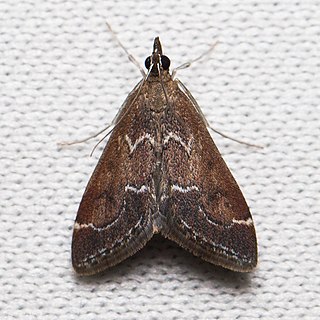
Hahncappsia is a genus of moths of the family Crambidae, and the order Lepidoptera.

Monoptilota is a genus of snout moths. It was described by George Duryea Hulst in 1900. It contains only one species, the lima-bean vine borer moth, which is found in the central and south-eastern parts of the United States.

Elophila gyralis, the waterlily borer moth, is a moth in the family Crambidae. It was described by George Duryea Hulst in 1886. It is found in eastern North America, where it has been recorded from Alabama, Florida, Georgia, Illinois, Indiana, Iowa, Louisiana, Maine, Maryland, Massachusetts, Michigan, Minnesota, Mississippi, New Brunswick, New Hampshire, New Jersey, New York, North Carolina, Nova Scotia, Ohio, Oklahoma, Ontario, Pennsylvania, Quebec, South Carolina, Tennessee, Texas and Wisconsin.
Agriphila biothanatalis is a moth in the family Crambidae. It was described by George Duryea Hulst in 1886. It is found in North America, where it has been recorded from California and Oregon.
Crambus trichusalis is a moth in the family Crambidae. It was described by George Duryea Hulst in 1886. It is found in North America, where it has been recorded from Alberta, Saskatchewan, Montana, North Dakota and South Dakota. The habitat consists of grasslands.
Prionapteryx cuneolalis is a moth in the family Crambidae. It was described by George Duryea Hulst in 1886. It is found in North America, where it has been recorded from Texas.
Abegesta reluctalis is a moth in the family Crambidae. It was described by George Duryea Hulst in 1886. It is found in North America, where it has been recorded from Arizona, California, Maryland and New Mexico.
Anania labeculalis is a moth in the family Crambidae. It was described by George Duryea Hulst in 1886. It is found in North America, where it has been recorded from Arizona to western Texas.
Hahncappsia huachucalis is a moth in the family Crambidae. It was described by Hahn William Capps in 1967. It is found in North America, where it has been recorded from Arizona and Texas.

Hahncappsia neobliteralis is a moth in the family Crambidae. It was described by Hahn William Capps in 1967. It is found in North America, where it has been recorded from Indiana, Iowa, Maryland, Mississippi, New Jersey, North Carolina, Ohio, Pennsylvania, Quebec, Tennessee, Washington, D.C., and West Virginia.
Hahncappsia pseudobliteralis is a moth in the family Crambidae. It was described by Hahn William Capps in 1967. It is found in North America, where it has been recorded from Arizona and Texas. It has also been recorded from Morelos, Mexico.

Hahncappsia marculenta is a moth in the family Crambidae. It was described by Augustus Radcliffe Grote and Coleman Townsend Robinson in 1867. It is found in North America, where it is widespread east of the Rocky Mountains.

Pyrausta napaealis is a moth in the family Crambidae. It was described by George Duryea Hulst in 1886. It is found in the United States, where it has been recorded from Washington to California and west to Arizona, Nevada, New Mexico and Texas. It is also found in northern Mexico.
Saucrobotys fumoferalis, the dusky saucrobotys moth, is a moth in the family Crambidae. It was described by George Duryea Hulst in 1886. It is found in North America, where it has been recorded from Nova Scotia west to British Columbia, north to Yukon, and south to Pennsylvania, Illinois and California. The habitat consists of boreal forests, mixed forests and woodlots.
Sitochroa aureolalis is a moth in the family Crambidae. It was described by George Duryea Hulst in 1886. It is found in the United States, where it has been recorded from southern California to Arizona and Texas. It is also found in northern Mexico.

Chloropteryx tepperaria, the angle-winged emerald moth, is a moth of the family Geometridae. The species was first described by George Duryea Hulst in 1886 and it is found in the southeastern United States.
Noctueliopsis bububattalis is a moth in the family Crambidae. It was described by George Duryea Hulst in 1886. It is found in North America, where it has been recorded from Arizona, California, Colorado, New Mexico, Texas and Utah.
Choristostigma roseopennalis is a moth in the family Crambidae. It was described by George Duryea Hulst in 1886. It is found in Mexico and the United States, where it has been recorded from Arizona, Georgia, Indiana, Maryland, North Carolina, Ohio, Tennessee and Texas.
Hydropionea oblectalis is a moth in the family Crambidae. It was described by George Duryea Hulst in 1886. It is found in North America, where it has been recorded from Arizona.
Udea octosignalis is a moth in the family Crambidae. It was described by George Duryea Hulst in 1886. It is found in North America, where it has been recorded from California and Texas.






